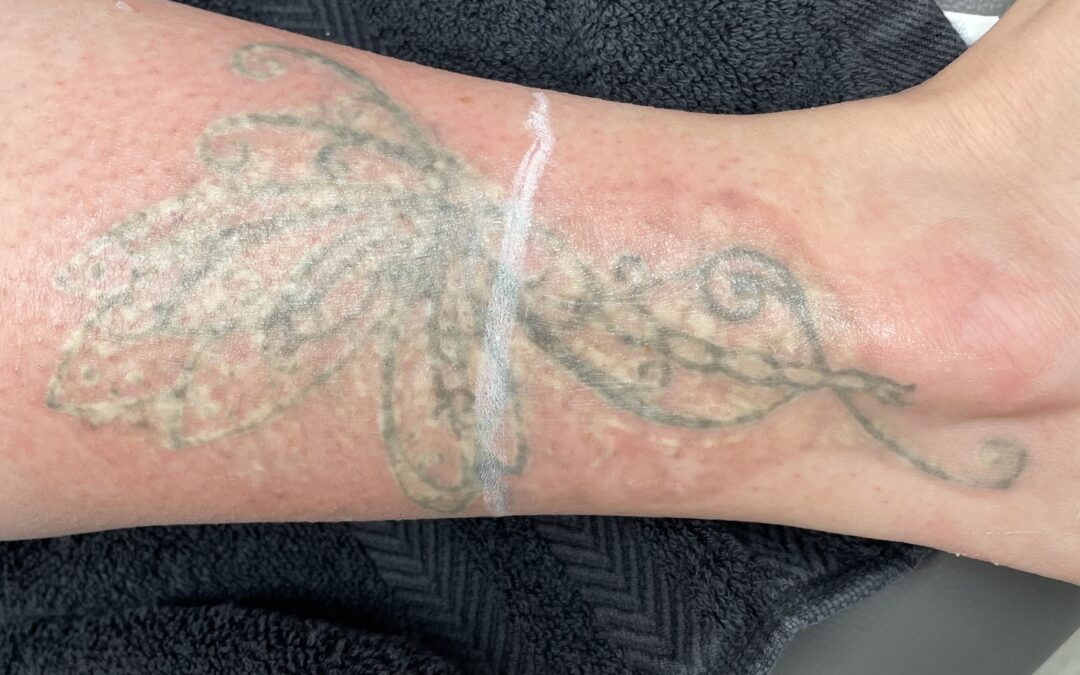The process of laser tattoo removal may seem like magic to some, but in reality, it’s grounded in science! While it’s an exciting procedure for both patients and practitioners, understanding the scientific principles behind it is key. In this blog article, we delve into the physics of laser tattoo removal to shed light on why it’s the most effective option for eliminating unwanted ink.
The Fundamental Laser Tattoo Removal Process
During a laser tattoo removal session, our laser technicians utilize a laser to target the tattooed area. Unlike conventional laser pointers emitting continuous beams, tattoo removal lasers emit pulses of light energy.
Each energy pulse penetrates the skin, where it’s absorbed by the tattoo ink. As the ink particles absorb the energy, they heat up and fragment into minuscule pieces. Over the ensuing weeks, the body’s immune system gradually flushes away these fragmented ink particles, gradually diminishing the appearance of the tattoo. With each successive laser treatment, more ink is broken down until the tattoo disappears entirely (in most cases).
Understanding Q-Switching
Q-switching, a specialized laser pulse creation technique, plays a crucial role in laser tattoo removal. Q-switched lasers generate brief, intensely powerful pulses of energy lasting mere nanoseconds. This rapid, intense energy pulse is integral to understanding how laser tattoo removal works.
Q-switched lasers are particularly effective for tattoo removal because they can heat and fragment the tiny ink particles without causing significant damage to surrounding skin tissue. The brief duration of the Q-switched pulse allows our laser technicians to selectively target and break down tattoo ink particles while minimizing collateral damage to the skin.
Precision in Targeting Tattoo Ink
Tattoos come in a myriad of colors, each absorbing and reflecting light wavelengths differently. For instance, a red tattoo appears red because it absorbs green light and reflects red light.
To ensure effective laser tattoo removal, it’s essential to use a laser wavelength that’s well-absorbed by the tattoo ink. For instance, green laser light is ideal for treating red ink tattoos, as it’s absorbed by the ink particles, causing them to heat up and fragment. Our laser technicians often utilize a variety of laser wavelengths to treat multicolored tattoos effectively.
Letting the Body’s Natural Processes Work
Laser tattoo removal isn’t instantaneous; it requires patience and commitment from patients. Most tattoos necessitate between 5 and 10 treatment sessions, spaced at least 6 weeks apart, for complete removal.
The need for multiple treatments stems from the fact that not all tattoo ink can be shattered in a single session. Additionally, waiting between sessions allows the body’s immune system to gradually flush away the fragmented ink particles, ensuring optimal results and minimizing the risk of side effects.
Exploring Alternatives
While laser tattoo removal is the most effective and non-invasive solution for unwanted ink, alternative methods exist. However, options such as excision surgery, CO2 laser treatment, and tattoo removal creams or injections are less effective and can lead to scarring or other complications.
In conclusion, laser tattoo removal stands out as the safest and most reliable method for erasing unwanted tattoos, offering individuals a chance to bid farewell to tattoo regret and embrace a fresh start.
